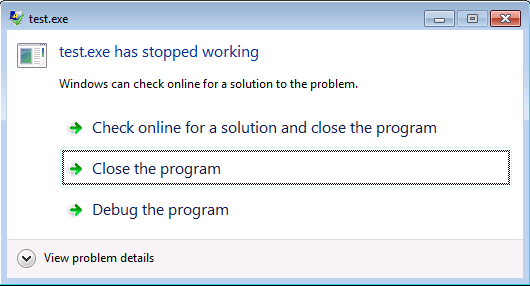C++ tips: AddVectoredExceptionHandler, AddVectoredContinueHandler and SetUnhandledExceptionFilter
I write below code to verify the behaviors of AddVectoredExceptionHandler, AddVectoredContinueHandler and SetUnhandledExceptionFilter:
#include "stdafx.h"
LONG WINAPI MyVectorContinueHandler(PEXCEPTION_POINTERS p)
{
printf("in my vectored continue handler\r\n");
return EXCEPTION_CONTINUE_SEARCH;
}
LONG WINAPI MyVectorExceptionFilter(PEXCEPTION_POINTERS p)
{
printf("in my vectored exception filter\r\n");
return EXCEPTION_CONTINUE_SEARCH;
}
LONG WINAPI MyUnhandledExceptionFilter(PEXCEPTION_POINTERS p)
{
printf("in my unhandled excepiton filter\r\n");
return EXCEPTION_CONTINUE_SEARCH;
}
LONG MyExceptFilter()
{
printf("in my filter\r\n");
return EXCEPTION_CONTINUE_SEARCH;
}
int _tmain(int argc, _TCHAR* argv[])
{
LPTOP_LEVEL_EXCEPTION_FILTER pOriginalFilter = SetUnhandledExceptionFilter(MyUnhandledExceptionFilter);
AddVectoredExceptionHandler(1,MyVectorExceptionFilter);
AddVectoredContinueHandler(1,MyVectorContinueHandler);
__try
{
//trigger an access violation here
int* p;
p = 0;
*p = 10;
}
__except(MyExceptFilter())
{
printf("in my handler\r\n");
printf("exception code: 0x%x\r\n",GetExceptionCode());
}
}
Build and then run the code on Windows 2003, get below result which is as expected:
in my vectored exception filter
in my filter
in my unhandled excepiton filter
in my vectored continue handler
We can see that:
1. The vectored exception filter (MyVectorExceptionFilter) is called before the frame based SEH filter.
2. MyUnhandledExceptionFilter gets called since the exception is not handled (EXCEPTION_CONTINUE_SEARCH is returned from previous filters).
3. Finally, the vectored continue handler (MyVectorContinueHandler) gets called.
However, runs the same code on Windows 7, we get below result:
in my vectored exception filter
in my filter
in my unhandled excepiton filter
then Windows Error Reporting gets involved and below window pops up, the vectored continue handler is not called:

Another thing to note: we know that MyUnhandledExceptionFilter is called by the kernel32!UnhandledExceptionFilter:
ChildEBP RetAddr
0020f880 77ec2c4a test!MyUnhandledExceptionFilter+0x1e
0020f908 77d85a74 kernel32!UnhandledExceptionFilter+0x127
0020f910 77d2d950 ntdll!__RtlUserThreadStart+0x62
0020f924 77d2d7ec ntdll!_EH4_CallFilterFunc+0x12
0020f94c 77d565f9 ntdll!_except_handler4+0x8e
0020f970 77d565cb ntdll!ExecuteHandler2+0x26
0020fa20 77d56457 ntdll!ExecuteHandler+0x24
0020fa20 00000000 ntdll!KiUserExceptionDispatcher+0xf
If you debug the code in Visual Studio (or run it under other debugger such as windbg), if you set a break point in test!MyUnhandledExceptionFilter and you will find the break point cannot be hit. This is because in kernel32!UnhandledExceptionFilter, it detects if the code is runs under a debugger if so, it just returns EXCEPTION_CONTINUE_SEARCH and the customized unhandled exception filter (test!MyUnhandledExceptionFilter in this case) is not called at all.
Comments
Anonymous
July 07, 2010
I noticed AddVectoredContinueHandler and RemoveVectoredContinueHandler in the MSDN Library but I'm having difficulty understanding the purpose of these functions. Can you describe some scenarios where one would want to define a continue handler?Anonymous
July 09, 2010
If the exception is still not handled after all your frame based SEH handlers are called, vectored continue handler will be called. This gives you the last opportunity to handle the exception in a way you want.